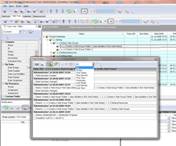|
This step of the PDCA cycle aims to determine real success of your improvement project in terms of the tools and processes you used during the Do step. It focuses you on reviewing the project and its progress to determine whether the work is performed according to the plan and whether expected results are obtained. You will measure performance of your project and procedures against desired changes. If any deviation (actual value differs from the target value) appears you will need to search for the cause of that deviation and develop a solution that addresses the problem.
As a process, the Check step of the PDCA cycle can be performed in these two major activities:
- Problem diagnosis
- Solution implementation
Generally speaking, these activities entail conducting problem-solution analysis that aims to determine why improvements to a given project are not implemented and then to design a set of scenarios that address the problem. Below in this article we will talk about both activities of the Check step and explain how to manage the activities and conduct the analysis. At the end of the article we present a checklist of tasks to manage the step.
Problem Diagnosis
This activity starts with reviewing measures created at the Plan step to determine actual improvements made by your project against goals or expectations. These measures help you understand whether the project implements the planned solution to make necessary changes to the working environment.
If the measures show that in your project there is a deviation from the baseline, you need to create Issue Log to record all the deviations detected. Then you use Issue Log to determine what tools and processes relate to every deviation detected. In such a way you will identify reasons for problems and determine why improvements are not made by the project.
In general, you must do the following tasks to diagnose problems:
- Use the measures set to determine actual improvements against preset expectations.
- Detect and record deviations.
- Create Issue Log that keeps all the records on deviations.
- Review Issue Log to diagnose real problems.
- Determine what tools and processes cause problems.
- Develop a report that summarizes the stage.
When all these tasks are done, you must review the problem diagnosis report to get a list of detected problems. By using Problem Evaluation Matrix (PEM) you can rank all the problems by significance in order to determine which problems to solve first. PEM is a flat table that ranks identified problems by significance and score to calculate weighted score per problem. Below you can see an example of PEM.
Problems Identified |
Significance, % |
Score |
Weighted Score/100% |
- Lack of financial resources
|
10 |
12 |
1.2 |
- Reduced employee productivity
|
6 |
8 |
0.48 |
|
3 |
4 |
0.12 |
|
15 |
20 |
3.0 |
|
… |
… |
… |
Total: |
100% |
--- |
X |
Each problem gains Weighted Score that determines how significantly the problem influences your working environment. You must weight all problems to focus on the most significant ones.
Solution Implementation
The second activity of the Check step requires you to review the most significant problems and then try to develop appropriate solutions. If you can’t develop a solution to a problem, you must loop back to the previous step for further diagnosis and investigation.
We suggest a 3-step process for implementing solutions to problems. This process includes the following steps:
- Identify the most effective way of implementation.
You need to determine possible ways of implementation while considering each selected problem and configuration requirements. Through analyzing these ways you will identify the most appropriate solution to each problem. It means you will get the best implementation way that entails the lowest cost, minimized time duration, and minimized number of iterations.
When the most effective way of solution implementation for every problem is determined, you need to develop a list of actions or activities required to follow this way. Also you need to define relationships between those activities. Prioritization can be used to solve this issue. Priorities should be set for every activity, so that the entire sequence of activities will be defined. Along with priorities, timeframes and boundaries should be set. You will need to estimate duration per activity and then determine activity boundaries.
When the previous steps are done, you can design a flow chart that represents all solutions to problems in a single diagram. You can use the input data (activity list, priorities, durations and boundaries) to start drawing squares and triangles and arrows between them. In such a way you will design a flow chart that illustrates solution implementation stages.
When all the steps are completed, you must get a detailed pathway to problem solving. Your project will gain improvements that increase the probability of success.
Using Tasks in VIP Task Manager
Below you can see a checklist of tasks that can be created in VIP Task Manager. This checklist explains what tasks to do to diagnose problems and implement solutions. You can use VIP Task Manager to design the checklist and manage tasks.
- Problem Diagnosis
- Use the measures set to determine actual improvements against preset expectations
 Detect and record deviations Detect and record deviations- Create Issue Log that keeps all the records on deviations
- Review issue Log to diagnose real problems
- Determine what tools and processes cause problems
- Develop a report that summarizes the stage
- Solution Implementation
- Create a list of possible solution options
- Conduct a comparison analyze of the options
- Select the most cost-effective option
- Identify stages of the implementation process
- Set priority per stage
- Set timeframes per stage
- Set boundaries per stage
- Create a flow chart
- Implement solutions.
|